
While sustainability at home is fun and important, I couldn’t skip past providing a section on work life. If you’re a technology professional, it’s easier than you think to focus on this space. In our space we can have an outsized individual impact by building the “scoreboards” to help make sustainability data driven. I hope to inspire you to help the world Take the Grey out of Green!
This article provides a case study in how to be sustainable at home, using the latest technologies and with an obsession for data. In reading this article you should be able to answer the following questions for yourself:
- What home and lifestyle choices will have the greatest impact?
- How is my current lifestyle impacted, what is lost, what is gained?
- How can I learn more about sustainability in my limited spare time?
- How can I teach my children the value of sustainability?

This obfuscation of the data, based on invented constructs (see Texas ERCOT, the Lonestar grid) makes it tough to be exact. However, these tools are what are available today, and are informative at least. A final lower tech approach can simply be to do a maps search for your location and search “Power Plant”. Although electricity can be “pushed” along copper with no physics based limitations, the losses in power and lack of connected long haul High Voltage (HV) lines mean you will likely be consuming from 1-3 plants within 200 miles of your front door. In our case this tells me that for the city of Portland, OR the 288g listed for Emissions Intensity is too high and too low for Sparks, NV.

Every year, the United States generates 4,000 million MWh of electricity from utility-scale sources. While the majority comes from fossil fuels like natural gas (32.1%) and coal (29.9%), there are also many other minor sources that feed into the grid, ranging from biomass to geothermal.
Do you know where your electricity comes from? This map is provided by Visual Capitalist in 2019 illustrates how simple being more sustainable is when it comes to emissions. Each fuel source provides and different emissions profile. Renewables sources are very low and petroleum-based sources are very high. Nuclear is low emissions but massively impactful by many other measures and therefore is not a sustainable a fuel, all things considered. The key takeaway is know where you get your electricity from and how it is generated.
Vocation, Vocation, Vocation
For all our efforts at home, they pale in comparison to the impacts I’ve had through my profession. In my role at Cisco, we were able to reduce Cisco’s net energy usage by 28% within 4 years, across 364 buildings globally. This is equivalent to removing a small city from the global grid. Through my book, I’ve been able to influence many others to follow the same path. Finding data on that is difficult as much of this work is done for labs and data centers who don’t typically share this type of data. Either way, Cisco was recognized as a Sustianability leader, winning Greenpeace’s Cool IT rankings several times.

Being able to connect my passion with profession has been very rewarding for me. Doing well by doing good gives me a strong sense of purpose and makes work a joy every day.
I’m assuming most of the readers of this post will be from the technology industry. That means you probably know how to change hearts and minds using data. If that’s you, I highly encourage you to get into the sustainability space. You might think its too complex and will take you too long. If you’re treating sustainability as a data problem, I can tell you it is not complex at all. It’s just a new focus area that needs technology experts like you to build new analytics.
Making sustainability data visible to resource managers and executives can have a massive impact. I’ve found most people want to do the right thing if you show them the data. It’s been my job for over a decade to do just that and the results have been epic.
Another big effect of making the data visible is you can create a competitive element. A keep up with the Green Jones’ approach really works well.
In addition to focusing on my day job in this space, I’ve also participated in key consortia that seek to provides standards for others to follow, like IEEE, OSI, Climate Savers Computing Initiative, Sustainable Digital Infrastructure Alliance, iMasons and The Green Grid. I’ve also provided pro-bono consulting where possible for organizations like the US Department of Energy’s and Lawrence Berkley Lab’s Data Center Energy Professional (DCEP) Program. This work has been more impactful than my day job as it’s enabled me to work with others to scale our impacts collectively.
Through The Green Grid, we were able to publish key metrics that provide data center operators a way to measure how good or bad they’re doing in terms of energy efficiency. Implementing energy efficiently directly translates into fewer emissions for the same amount of work. Since we released Power Usage Effectiveness in 2010 it has now been adopted as a global standard under ISO/IEC 30134-2:2016.
Eric Masanet from the University of California Santa Barbara has been tracking the adoption of PUE by data centers over the years and the results are impressive.
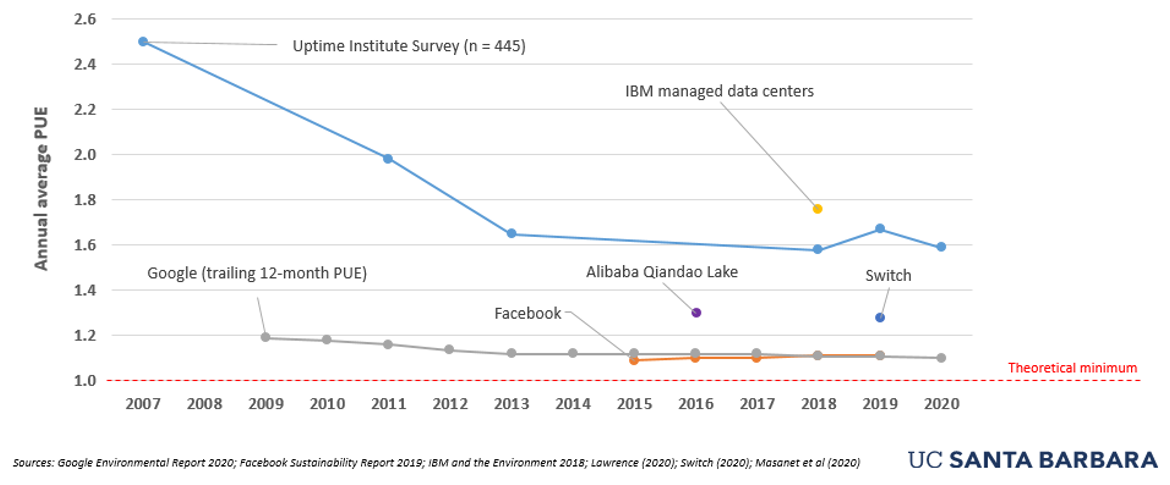
This chart shows clearly that when we give people a sustainability data standard to follow, it gets followed and creates a sense of competition. If you really want to have an outsized global impact, you can likely do much more through your work life than at home.
Making Sustainability Data-Driven
There are some great tools out there you can use at home or work to make sustainability improvements data driven. The US Environmental Protection Agency (EPA) provides us with different categories of Greenhouse Gases (GhG) that can be measured through Equivalencies (GhGe). These categories at Emissions Scopes 1,2 and 3. This provides us with an analytics framework to identify where emissions are being generated and what activities correspond.
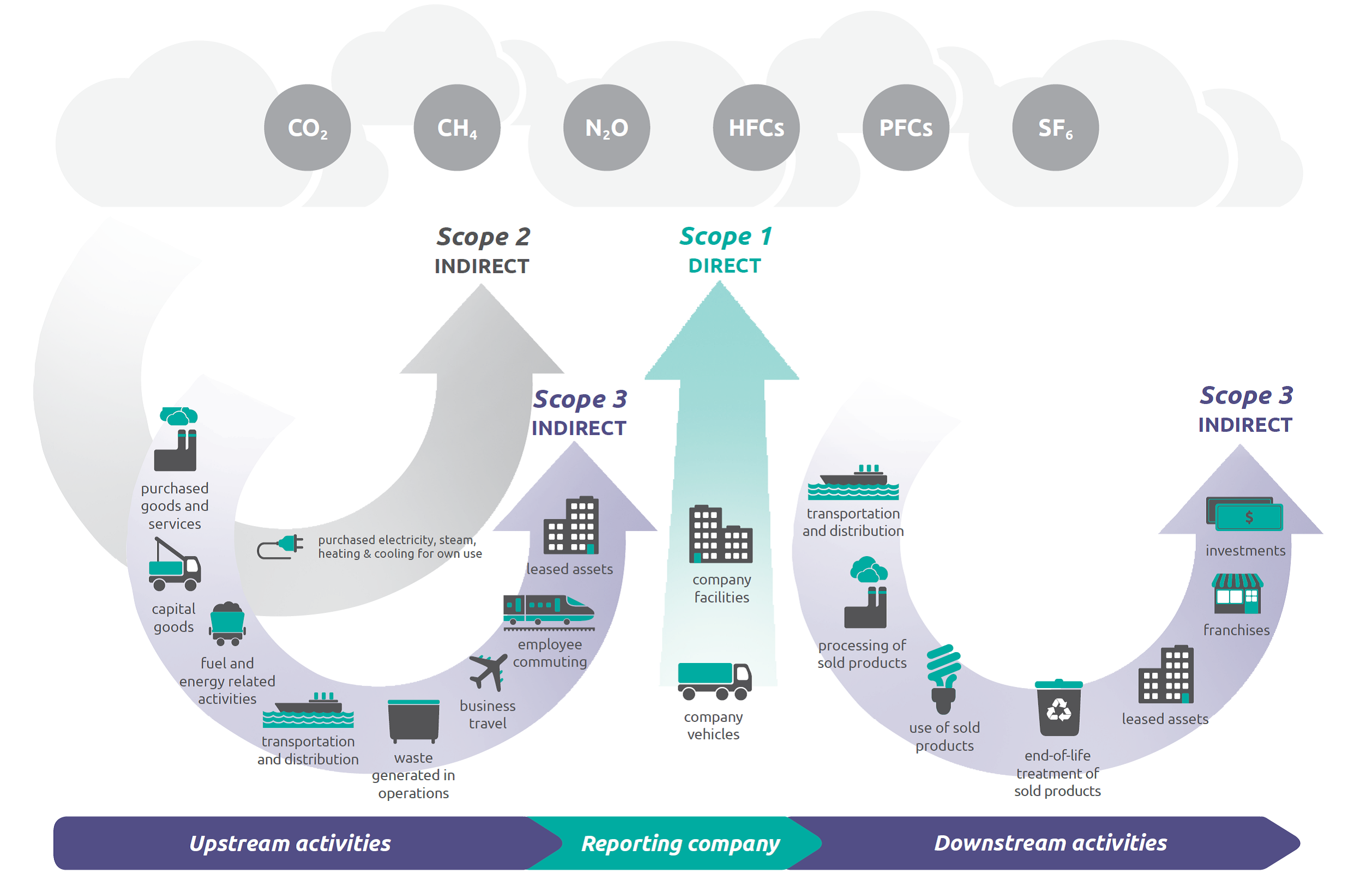
The Scopes of Emissions and How they are Applied
These scopes are useful in determining where emissions are being produced and what activities they ultimately support. An easy way to conceptualize the 3 scopes is by thinking of them in terms of a physical or geographical model. Let’s take an Electrical Utility provider as an example. As a company, their product is electrons. They make this product using coal as the input if you follow global averages. The emissions that are generated from this input (coal) is categorized as Scope 1. They sell this product as electricity to the market. Let’s say a concrete company makes a given quantity of their product using this electricity. This concrete requires inputs (electricity) that can be measured as Scope 2. Finally, lets say this concrete is purchased by a company to construct a new building, this is now measurable as Scope 3 or the embodied emissions of that building for the concrete that is used.
In focusing on your home, it’s relatively straight forward. The main impact for your home for most us, is the electricity we consume. This is because most of the electricity we use globally comes from dirty sources. So you can start with your utility bills to simply see how much energy you are using month in month out. This is your first step towards setting your own personal baseline!
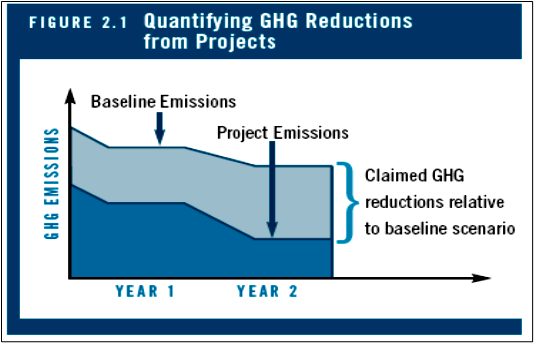
BASELINING YOUR EMISSIONS
An emissions baseline is the reference point against which a home, business or country’s GHG emissions can be measured going forward. Baseline emissions are calculated by looking at a ‘baseline emissions period’, usually the past 1 – 5 years of an organisation’s activity. If no action is taken to reduce emissions, this is the level at which they can be expected to remain.
Whether at home or work, this approach allows you to set a number that improvements can be measured against. Starting with home electrical usage, natural gas (if you use it), then including your travel and finally anything you might make at home. This is the extent of it for most homes when it comes to emissions. In addition to emissions, we’ll talk about waste streams and re-use, recycling in later sections.

For converting your home electrical usage or gasoline consumption into emissions, there is a handy calculator from the EPA for this very purpose. From there, you can take the outputs and plug them into this Simplified GhG Emissions Calculator. This tool is an extensive .xlsm file and you’ll want to look at the Electricity worksheet to get started. This is the very same spread sheet I’ve been using for years to track our home operations.
At this stage you’re taking the first step in implementing a sustainability focused transformation. You are commonly measuring your sources of impacts and establishing an extensible data framework for tracking how you are doing on improvements. A deeper dive on baselining in Chapter 5 of the EPA’s Guidelines for Preparing Economic Analysis.
Reducing Emissions Through Transformation
Now that you have a baseline in hand, you can commence on a new project to improve your impacts and better understand your emissions profile. Here is where having a transformational method is important. There are a lot of options here but I’ll recommend the approach I’ve used for years to help large companies reduce their own impacts. I call it the 3M’s for the 3R’s. Most of us recognize the 3R’s – Reduce, Reuse, Recycle as an easy way to translate sustainability from a noun to verb in our minds.
Similarly, but specific to the technology industry, a simple way is needed to do the same for this industries role in supporting global sustainability. Starting with common Measurement that can be standardize at the networks edge. With that in place you can Monitor your efforts to improve and finally you can automate how you Manage these changes to ensure they deliver against your targets. Here’s an illustration of how it works for many buildings, but the same approach can be applied to your home.

A deeper dive is available from the World Resource Institute through The GhG Protocol for Project Accounting. and through the EPA’s Simplified Guide to Greenhouse Gas Management for Organizations.
Our Sustinability Story

Our Solar Installation
Our Solar Installation
Our solar installation + battery paid for itself quickly and provides us with a new level of energy independence during grid outages. To extend battery runtime, we’ve designated certain power outlets in the home to run off battery. This is a crude but effective way to prioritize stored energy to critical home assets like freezers, refrigerators, water pumps and lights. We do not run electric heating assets from the battery, relying on stored propane at home for heating and cooking in emergency situations.
Installing renewable energy will have the largest impact for your home operations for most people. This will reduce your reliance on dirty grid sources and if you install battery storage you can enjoy another level of comfort and security when the grid goes down.
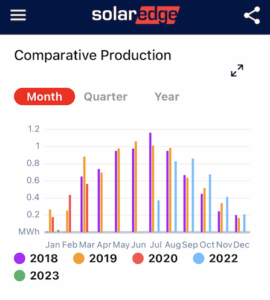 In many developed countries you will find both National and State level incentives to install solar panels. We took advantage of the Federal Solar Incentive provided by the US Obama administration coupled with an Oregon State incentive program. Combined, these programs provided a significant reduction in the capital we needed to invest. From there, our initial investment had a payback period that was easy to calculate. We went with Solar Edge as our provider, partly because their app is good but also because they don’t use Tesla’s system.
In many developed countries you will find both National and State level incentives to install solar panels. We took advantage of the Federal Solar Incentive provided by the US Obama administration coupled with an Oregon State incentive program. Combined, these programs provided a significant reduction in the capital we needed to invest. From there, our initial investment had a payback period that was easy to calculate. We went with Solar Edge as our provider, partly because their app is good but also because they don’t use Tesla’s system.
In our case, in rainy Portland, OR, we weren’t sure if there was enough Irradiance to provide an attractive payback period. US estimates at the time, provided by the US Dept of Energy projected a 7 year payback based on US averages of which we were on the low end of. We achieved our payback period is just over a 6 year period and now that our investment has been recouped, we pay less than $28/month on average over the year for electricity services to our home, down from about $100.
Estimating your solar capacities is easier since the release of the Global Solar Atlas. This resource helps you determine how much solar irradiance is in your region on average. However, basing it off of our results in Portland, OR with fewer sunny days than most regions, you will likely have a fast payback period.
Estimating Your Solar Irrandiance
Solar and Wind in Your Region
The World Bank and the International Finance Corporation, collectively The World Bank Group, have provided this Global Solar Atlas in addition to a series of global, regional and country GIS data layers and poster maps, to support the scale-up of solar power in our client countries. This work is funded by the Energy Sector Management Assistance Program (ESMAP), a multi-donor trust fund administered by The World Bank and supported by 13 official bilateral donors. It is part of a global ESMAP initiative on Renewable Energy Resource Mapping that includes biomass, small hydro, solar and wind.
How We Roll
Bike Don't Drive
Luckily we live in a bike town. Portland, OR has many bike lanes and a lot of people ride here. This means there is always a lot of stock of used bikes. We looked at Craiglist, Nextdoor and FB marketplace and were able to get what were in essence brand new, high quality mountain bikes for the family for about $250/each. We bike to the grocery, farmers market and go mountain biking on the weekends. This is a great way to stay healthy and reduce your emissions related to transport and play. I’d recommend saddle bags as an add on that make it easy to run errands day in day out.
Working from home and biking to and from the grocery and for other errands will have a cumulative impact. Electric Vehicles (EV’s) are also great but consider the emissions of the grid you’re using to charge it. Biking is the lowest emissions option out there besides walking.
If you physically can bike and are in a region/city where you can do that safely, its a great way to reduce your emissions related to transportation. This is just one of many benefits of adopting a biking lifestyle. We opted for mountain bikes for a couple of reasons. First, they are ruggedized and built to last which has an impact on the Scope 3 emissions related to how many bikes you own throughout your life. Second, we get to go out into nature on the weekends and explore the beautiful outdoors.
Some other tangential benefits we’ve noticed are; biking just slows you down a bit. You see more of your city, your neighbors, the local wildlife. You also use Calories not Coal as your fuel source, this helps your physical fitness as well.
How We Shop
Buy Used, Refurbished and Ugly Veg
Whether its Goodwill in America or The Salvo’s in Australia, most developed economies have a strong second hand market for just about any good you can think of. You mobile phone providers and laptop company likely provide and refurbished option and many apps help you find free stuff. It might take a shift in your thinking to buy used clothes but giving everything a good wash when you get home does the trick. France’s Intermache has an entire supermarket chain that just sells ugly vegetables at a 30% discount. Their marketing is hilarious and celebrates the might of the Inglorious Vegetable.
Scope 3 typically emissions relate to the energy and corresponding emissions that are created when making and transporting a physical product. A simple focus on reducing the number of new things you purchase and reusing the things your already have will have a big impact.
Benchmarking your Scope 3 emissions is likely more than you need or want to do for sustainability at home. In our case we kept it simple and decided to not buy anything new as much as possible. This has saved us on emissions but also a lot of money by avoiding the premium anyone pays for something new. We get most of our clothes at Goodwill, we buy electronics refurbished, buy bikes used and found out it’s a lot of fun! Like a scavenger hunt of frugality.
It might seem a little weird to buy used clothes at first but we’ve been happy with it. That said, there are certain clothing items we only by new, like underwear and socks. Another approach you can use here if you buy new is to consider where the product is coming from. Buying locally will reduce the energy used to transport the product to you. This is where Amazon is making efforts to electrify its fleet that will reduce emissions related to transport. If you really want to be savvy you can use the Electricity Map Application to see what the Emissions Intensity of the region is that you’re getting a product from. For new products, the best way to drive down your Scope 3 emissions is to simply buy from suppliers that make their products in low emissions regions.
How We Eat
Grow Your Own
As South Central LA’s famous renegade gardener: Ron Finley said at TED2013; “kids who grow tomatoes, eat tomatoes”. We put in our backyard a 4′ x 8″ raised bed for each family member. We compete to grow the tastiest veg and share the winnings. To make it easy and because I’m a nerd, I put in an overhead watering system that I’ve tied to sub-soil humidity sensors and connected through an IoT App I developed while at Hitachi. This means the gardens only get watered when the soil needs it, avoiding over watering and the daily water hose.
When I feed the poor, they call me a saint. When I ask why so many people are poor, they call me a communist.– Dom Hélder Câmara, Brasil’s “Archbishop of the Poor”
How We Forage
Get Your Chowda' On!
One of our favorite things to do as a family is to get our own food from nature. I grew up learning how to make Chowder from scratch from my Grandmother Betty on Prudence Island, RI. To make it, we needed to first get the clams. We’d find them using the same technique that was taught to early Europeans by the Narragansett Tribe. We also spearfish, lobster, crab, lobster and mushroom forage. If you are harvesting from a pristine environment, there is no healthier way to eat and its a lot of fun. It’s also teaching our children how to live without being reliant on a grocery store.
“ Global population is expected to exceed 11 billion people by 2100 unless actions are taken to stabilize population growth. Healthy diets from sustainable food systems are possible for up to 10 billion people but become increasingly unlikely past this population threshold.”– EAT-Lancet Commission, Landmark Report 2019
How We Build
No More New Wood!
I’ve taken up carpentry as way to build furniture for the home. With our renewable energy powering our tools and easy access to reclaimed lumber, we don’t need to buy as much new furniture. I source most of the wood I need from Nextdoor, Craigslist and FB maretplace for free. We also harvest wood from the coastlines and from dead trees in the forest. In addition to carpentry I’ve taken up dry set masonry which replaces what would otherwise require concrete which is very energy intensive.
Material footprint per capita in high-income countries is 60% higher than in upper-middle-income countries and more than 13 times the level of low-income countries.– United Nations
How We Travel
Rail Instead of Shorter Flights
Its just not practical for us to take trains cross country when we go back east to visit family but it’s easier than ever to do it for regional travel. Rail is a very, very efficient form of land travel. The lack of friction between the track and wheels means most of the energy delivered from the engine goes directly to locomotion. By comparison, an automobile using a gas combustion engine delivers only 12-30% of its energy to the wheels of the car. The rest is lost to drive chain inefficiencies and powering of components, as detailed by the US Dept of Energy.
Take only memories, leave only footprints.– Chief Seattle, Duwamish and Suquamish tribes
How We Handle Waste
New Recycling Options
Recycling only works so well and based on recent studies, its hard to trust that the system is working at all. For us this means we do everything we can to reduce anything that is single use. For recycling, we’ve hired the experts. Ridwell is a new company our of Seattle, WA that specializes in a wide range of recycling and responsible disposal services. We’ve been very happy with it and this article from another Portland parent does a great job of breaking it all out. Unfortunately these services are not available in all areas. In addition to recycling, we bring our own bags and containers to the grocery store, compost all food wastes and use the soil created in our garden. Dive deeper through EPA’s Waster Reduction Model (WARM).
I went to the trash pile at Tuskegee Institute and started my laboratory with bottles, old fruit jars and any other thing I found I could use. … [The early efforts were] worked out almost wholly on top of my flat topped writing desk and with teacups, glasses, bottles and reagents I made myself.– George Washington Carver, American agricultural chemist and agronomist
Unfortunately many people in the business world only see Sustainability through the lens of loss. There is a strong misconception that being more sustainable means you can’t own anything unless its tie-dyed and have no understanding of how the world really works. The good news, this is just ignorance and in most cases that is a curable condition.
Starting with how you look at it for your home, you’ll see it’s the same approach for a business. The lifestyle you enjoy requires a certain level of resource and time inputs. Those inputs are a component of a consumption model which can be applied to a home or office. Resource Matters provides a great write up on global resources and consumption. This article provides an Introduction to Global Sustainability considerations. I recommend reading this to start framing out your understanding of sustainability as a resource management challenge.
At the highest level, our impacts can measured by the inputs (resources) consumed and the outputs (useful work and waste/pollution) across human and natural systems. The World Wildlife Fund (WWF) provides this figure, showing both and illustrating how they all directly proportionate to human population.
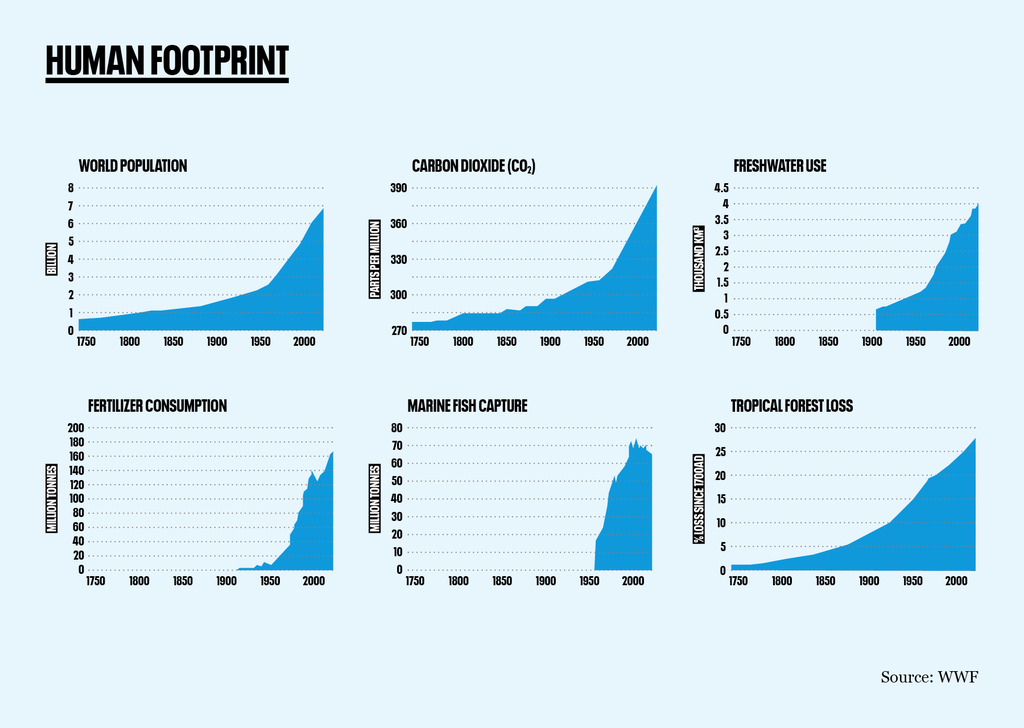
Just based on this high level overview, you can see a pattern of your own personal consumption start to emerge. We all use water, most of us can use less. Many use industrially manufactured fertilizers instead of natural ones. Using reclaimed wood is not the norm and so on. For your home “operations” you can look across the inputs (water, electricity, food, goods and services) and ask yourself in you can Reduce, Reuse and Recycle that input and where you cannot, seek out the least impactful approach or option.
The first thing we lost was confidence in the current global economic accounting system as it exists today. The deeper you get into sustainability in academics the more it starts to look like economics. Initially I was excited by the prospect that there is this global financial system that was already in place that could help fix things, a la the free market. Just show people the costs of pollution, habitat destruction, healthcare issues related to pollution, water, jobs and things will naturally correct. However, I realized after some years of dedicated focus that the current global economic systems works against sustainability. Not because sustainability is a net financial loss, its because the full lifecycle costs related to environmental degradation aren’t even accounted for. PNAS provides an excellent review of where things stand today between natural and economic sciences.
This reality of today, with an obsession for short payback periods, high profit and never ending growth makes things challenging. In our case, we’ve chosen do what we can based on our means. This means we buy Organic and sustainably harvested foods. We pay a premium for that and some weeks we just can’t afford it. We paid a premium for our solar installation but that was offset by incentive programs. Without those programs we could not have afforded it. We use lower emissions transportation but it adds extra time and requires more planning. Taken all together, I don’t see these as losses. I see these as transitional conditions where economies of scale have not kicked in yet.
In the case of our home economics, we’ve not seen a economic loss and the premiums we’ve invested in make sense if we extend our payback expectations from the typical 1-3 year, out to a 5-10 year one. This made solar viable for us but not an Electric Vehicle. We just don’t drive enough for an EV to make sense and our bikes fit the need for basic errands around town.
Anyone who believes in indefinite growth of anything physical on a physically finite planet is either a madman or an economist.– Kenneth Boulding, economist
In a word, Respect. The origins of this word are Latin and roughly translate into fully seeing something, fully considering it with all of your attention. We gained an appreciation for how finite our resources are and how disproportionately they are allocated. This IISD article provides a good overview of how environmental degradation affects the poorest among us far more than those who are well off. As you learn more about these issues, your place in them becomes clear. If you understand your place in the problem you can start to take steps to be part of the solution. In the process you will develop a deeper respect for our Mother and feel more connected to her in ways you might not expect.
More specifically, we’ve gained hard cash. Over the 10 years we’ve lived in Portland, our expenses have seen a net decrease (normalized for inflation of course). There have been some increases in our food budget and a short term increase related to the solar installation. Other than that the results have been, by any economic measure, an improvement to our bottom line. We’ve tracked this over the years using good old .csv/excel. The net improvement, expressed as a percentage improvement from our baseline costs in 2010 when we moved to Portland comes out to 19% net gain across the 6 categories we’ve tracked. The net total dollars vary by category but its roughed out to about $90/month on average that we’re not paying as compared to our baseline.
While not a monetary gain, myself and the whole family have gained a shared sense of purpose. A focus on doing good for others even though they’ll never know it was us. Doing good for goods sake is one of the best lessons we’ve been able to share with our children. There have a number of psychological studies that highlight the importance of purpose to long term happiness and health, as detailed in this article by Psychology today.
This may not apply to all but I find learning a new space very stimulating, particularly when its has the potential to benefit all life on the planet. I find myself reading late into the night about all kinds of new sustainable approaches and as I do, I feel like a true pioneer, focused on work that matters. While tech provides a lot of opportunities to specialize, once you do and master a particular domain, it can quickly become boring (there are only so many ways to configure a database!). I have yet to get bored focusing in this emerging space of sustainable technology development.
Through our adoption of EcoTourism practices for our holidays, we’ve also been able to gain a deeper understanding of how Native peoples live. When we travel on holiday in America, we often will travel near or through native lands. These Native lands usually have a Tribal Council HQ you can reach out to before you travel. The councils typically have an administrator you can speak with. They have a good sense of what help is needed in the community and you can volunteer your time and skills. This may sound like working on holiday but it never feels that way for us. It’s often the highlight of our trip because we learn a lot more about the people, place, food, culture, dance and song. This cultural exchange builds bridges and understanding between the ancient and modern. Somewhere in between is the progress we can make through shared learning.
Finally, I feel a strong sense of pride as a Father and provider. When I’m done with my work for the day and share a meal with my family, I look across at our children and I know I’m working towards their future. I know I’m applying my expertise in technology to work that will matter for generations, to all peoples, not just the wealthy. I see my technical and business transformational knowledge as the value I bring and I have a choice in where I apply it. Unfortunately this does limit my options for work as the lack of attention from executive leaders in this space translates into very few dedicated sustainability roles that aren’t focused on greenwashing. The good news is this is changing and there are more Chief Sustainability Officer (CSO) roles that at any point in history.
I often get asked to provide a basic introduction to sustainability. First, lets be clear that Environmental Sciences is an inter-disciplinary field of study. So provding a basic introduction to people with no natural sciences background is difficult at best. That said, the natural sciences you’ll want to be at least familiar with will mainly focused on Atmospheric, Oceanographic, Physics, Chemistry, Hydrology, Geology, Agriculture and Forestry. On top of these foundational sciences, its very helpful to look at the analytic methods that are used to estimate environmental impacts. Source, Transfer and Fate of pollutant analysis helps to illustrate the dynamics between these sciences and can be applied to estimating how a pollutant moves through a given environment. A simplified view is provided in this illustration, showing how pollutants get from A to Z.

As you can see in the illustration, the transference of pollutants largely follows the hydrologic cycle. Water is often what helps to move a pollutant and why most of all land based pollutants eventually end up in the oceans. This is where my degree focused; working backwards from the oceans to determine what, where and how land based sources were contributing impacts.
Given the most pressing threat to the biosphere today is climate change, it’s important to have a basic understanding of Greenhouse Gas (GhG) emissions. When I was a CSO and a vendor would approach me to sell a sustainability solution. Then, like now, they all talked exclusively about Carbon. All these buzz terms; decarbonization, netzero carbon, carbon foortprints and more just end up sounding less than credible to me. It got so bad I came up with hack to see if the company had even a basic understanding of sustainability; I would simply ask the sales or marketing person to tell me what other Greenhouse Gases they could help me with. That was usually met with a blank look to which I would ask a follow on; can you list for me to top GhG’s in order of atmospheric concentrations. When neither of these could be addressed I knew it was time to wrap up the meeting.
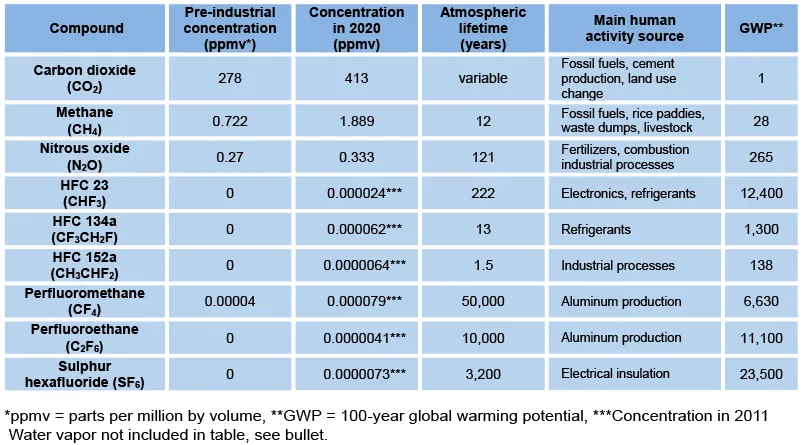
There are 10 primary GhG’s and what surprises many is that water is the most abundant GhG in the atmosphere. In this regard a GhG is not by definition a pollutant but many of them also carry pollutants with them when not naturally occurring, measure as Particulate Matter (PM). The most common pollutants come in the form of heavy metals and persistent organic pollutants (POP’s). The University of Michigan’s, Center for Sustainable Systems has a great resource guide you can dive deeper on to learn more about the Greenhouse Gas effect and what is driving it. Hopefully as people learn more, we’ll see Carbon give way to GhG’s, much like Green has given way to Sustainability in the last decade.
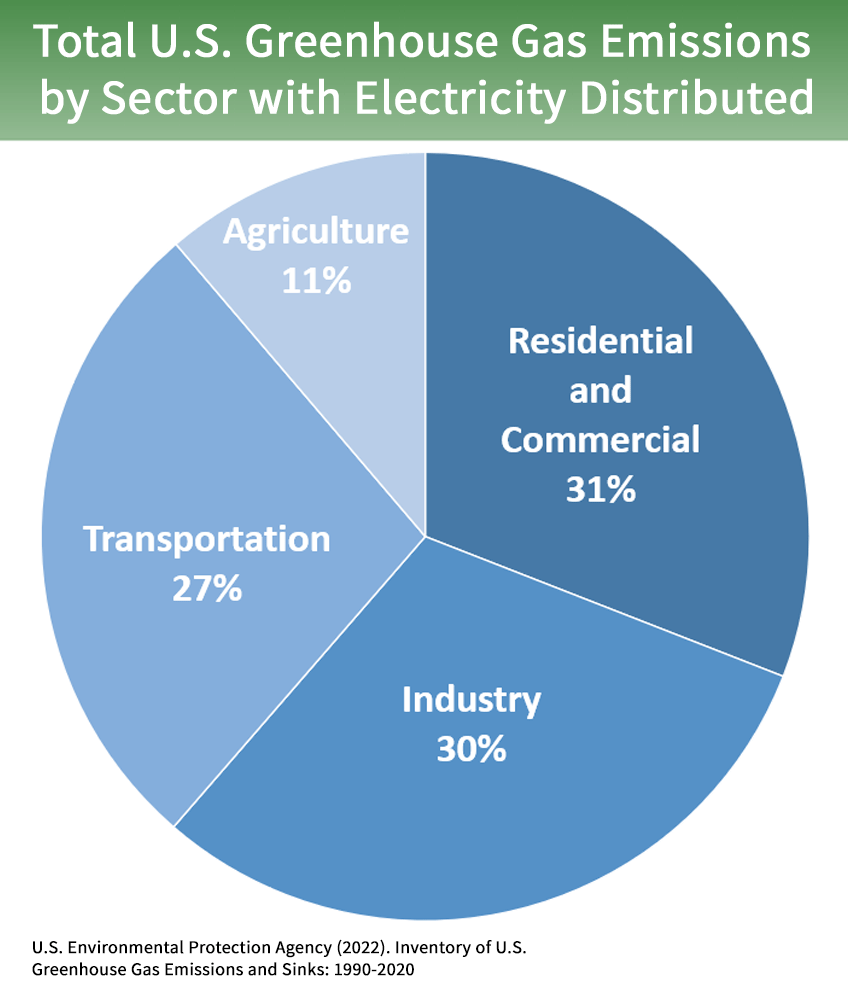
There is a pervasive belief that sustainability is too complex on top of the its all about loss mindset discussed in prior sections. There is now evidence that a lot of this confusion, like pollution, is human made. The Guardian and others have published articles, showing how Big Oil has known for decades that their profits come at the cost we’re all now seeing. There is also a lot of marketing from those who profit from environmental degradation that intends to sow seeds of doubt and make the whole problem look harder than it is.
As someone who understands the problem well, I can tell you at the highest level, its pretty simple. As a species, we use a lot of electricity, mainly in buildings. We fuel our buildings primarily with Coal (about the dirtiest thing you can burn). Next we’re always on the go, love the independence of driving ourselves and we mainly fuel our cars and trucks with petroleum. A distant third is Agriculture. So at this stage the problem is 1) the fuel source 2) how efficiently it is used 3) where it is used and 4) to do what.
So this leaves you with some simple options moving forward. The simplest of all, with the most rapid results would be for legislators to mandate no and low GhG fuels. If the world’s utility grids were all renewable, the drive for energy efficiency would no longer be in the name of sustainability. Using energy more efficiently at that point would simply be a cost management exercise. The politics of today in the USA would suggest our legislators will not be doing this anytime soon. This is where I encourage you to support Climate Voice, founded by one of the first CSO’s in Silicon Valley and a mentor to me over the years, Bill Weihl. It is their mission to ensure a companies lobbying agenda reflects the sustainability agenda as outlined in their annual report. If the 2 are different, there might be greenwashing afoot.
However, we do know legislators respond to lobbying. It’s not practical for me or you to individually lobby for environment. But it is for the companies we work for. Pressuring your company and your CSO, who often works closely with your Head of Government Affairs in the form of employee feedback is something we should all be doing. I joined my current employer, Amazon Web Services, in part because of an article I read, showing how more than 6,000 of our employees signed a letter to our leadership, in essence lobbying the executive corp to do more. It’s this kind of bottoms up action that I think is needed to make big changes to how a company operates.
If we look a bit deeper into the problem we quickly find that buildings are centralization of energy usage and activities. However, buildings don’t use any energy at all, they just keep the rain of the things that do. It’s the air conditioners, lights, pumps, labs, data centers, conveyance systems, robotics, compute, network and storage equipment. Basically anything that plugs into the wall. There have been improvements that are delivering results in buildings already. We mentioned PUE adoption earlier, the Energy Star Program and just more general awareness are driving net emissions down. However, there is still a lot of improvement potential for building, with the US Dept of Energy showing as much as a 20% improvement opportunity today.
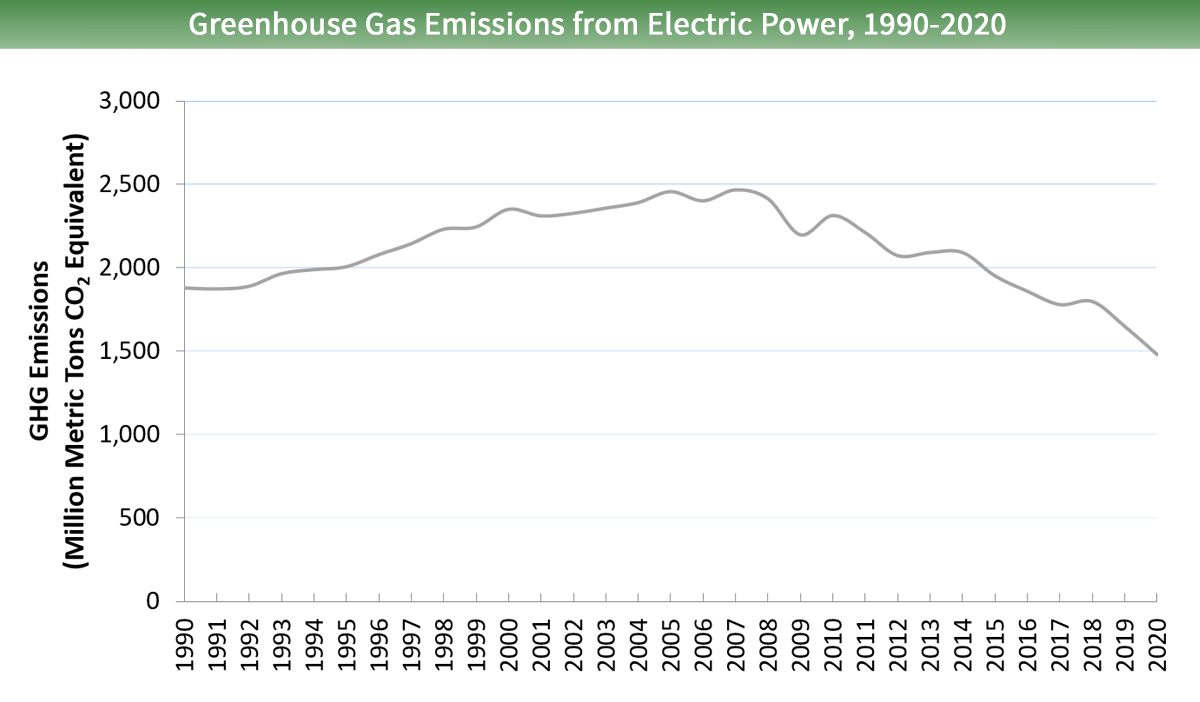
A big reason why buildings run inefficiently is that they’re just not well managed. This has little to do with the people and everything to do with the antiquated technologies used to manage buildings. All the worlds major Building Management Systems (BMS) use networking technologies that predate Internet Protocols (IP’s), instead utilizing IP’s great grandfather; Supervisory Control and Data Access (SCADA). This approach makes it very difficult to manage the efficiency of these systems using contemporary Information Technology (IT) approaches. A good but smaller scale example are the many Smart Thermostats now available on the home market. Even with these new products, you still end up wiring in dry contacts from an HVAC unit as both the BMS and building infrastructure products still have yet to invest adequately in native IT approaches. This is changing slowly and ultimately being driven by new workers entering the building marketplace that have grown up with a higher level expectation of data services, driven by a smart phone in every pocket.
If you’ve read this far, you’re likely getting hooked! Before you go and pay for a course, take a look at all the free resources that are out there. The good news, the sustainability domain tends to adhere to an open source mindset. For American Universities this means they put a lot of there coursework out to the public, for free. The coursework ends up being 2-3 years behind the current curriculum but that’s fine for getting started. I’ve put together a list of good sources for further learning below.
- The Massachusetts Institute of Technology’s (MIT) Open Courseware for Sustainability
- Harvard University’s EdX; Free Sustainability Coursework
- Collection on Global Universities offering free online courses from MBA Central
- For Corporate Level Transformations and Global Energy Economics; Free Chapters from my book are available
First, learn from my mistake of telling younger children that Sustainability Starts with Making Your Bed. While I believe this to be true, it’s not popular framing of sustainability with kids. The comment was inspired by this speech by a US Navy Admiral. At the heart of it is, sustainability starts with cleaning up your own mess first. Then extending that beyond your bed to your home, to your yard, to your neighborhood and just keep going!
While this works for adults, I find kids (myself included) are most connected to sustainability through nature. I became an environmentalist in 1984 as a young child. I know the place, the time and why. We were living in Saudi Arabia and my parents took us to the Red Sea. This sea has some of the most pristine coral reefs in the world. I’d seen pictures but I had never seen a reef in reality. From a simple afternoon of snorkeling, I was transformed forever. The symphony of color, movement and life was like nothing I’d ever seen. I remember thinking, how can this exist and nobody knows about it. And how just moving my mask from air to sea, separated by a few inches of water, was like traveling to a distant universe, full of alien life.

Now it’s not practical for most of us to get to a coral reef. However, this experience can be found just about anywhere in nature. Both our children are sustainability minded already in their teens. This has come to be without a reef. We’ve done it through getting them out, away from people, where they can slow down and get in synch with the pulse of nature. The US has some of the most magical parks in the world, get them out into them. Skip Disney or that cruise for this years holiday, take them to a park, rent a cabin, explore and unwind. Take them for hikes, buy some used mountain bikes, maybe a family canoe. There are so many options but the point is, commune with nature.
I can also promise you that if you take the time to learn this space and teach it to your children, you will bond over it. It will show them you are committed to their future and are willing to make real changes to ensure its’ bright. Where we live in Oregon, we are very proud of our youth who filed suit against the government, suing them for not doing more to combat climate change. Sadly this was defeated, but these children and their unofficial spokesperson, Greta Thuneberg. are committed and I find them inspirational.
If travel into nature doesn’t work, there are literally hundreds of documentaries that are informational and often entertaining. BBC Earth and their series are particular favorites of ours and of course the famous Croc Hunter, Steve Irwin and his remaining family in Australia. Whatever your approach, your kids values will largely reflect your own. So, make your bed first and lead your kids by example.
I firmly believe that nature brings solace to all problems.– Anne Frank

Let me know if you’d like to see an expansion on this topic. For sake of length, I’ve left out the home tech’s I use and how we handle lawn and garden care. You feedback helps. Thanks for reading!